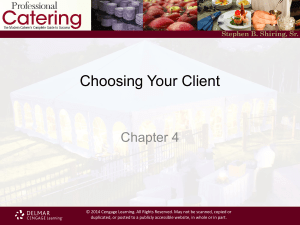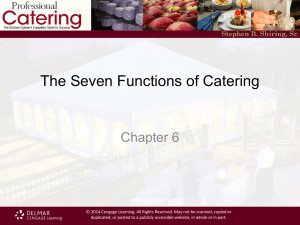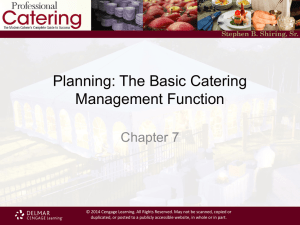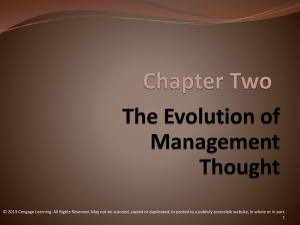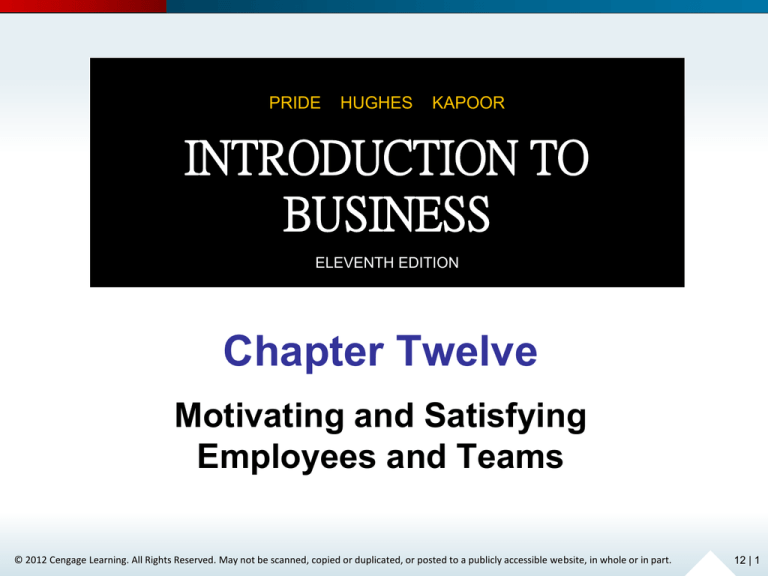
PRIDE
HUGHES
KAPOOR
INTRODUCTION TO
BUSINESS
ELEVENTH EDITION
Chapter Twelve
Motivating and Satisfying
Employees and Teams
© 2012 Cengage Learning. All Rights Reserved. May not be scanned, copied or duplicated, or posted to a publicly accessible website, in whole or in part.
12 | 1
Learning Objectives
1. Explain what motivation is
2. Understand some major historical perspectives
on motivation
3. Describe three contemporary views of
motivation: equity theory, expectancy theory,
and goal-setting theory
4. Explain several techniques for increasing
employee motivation
5. Understand the types, development, and uses
of teams
© 2012 Cengage Learning. All Rights Reserved. May not be scanned, copied or duplicated, or posted to a publicly accessible website, in whole or in part.
12 | 2
What Is Motivation?
Define Motivation
Define Morale
• From what does high morale result?
- What are the outcomes of high morale?
• What causes low morale?
- What are the consequences of low morale?
© 2012 Cengage Learning. All Rights Reserved. May not be scanned, copied or duplicated, or posted to a publicly accessible website, in whole or in part.
12 | 3
Historical Perspectives on Motivation
Know the different historical perspectives on motivation
What is the Scientific Management perspective?
• Who was Frederick W. Taylor?
• What was the outcome of espousing this theory in a
firm?
Explain Taylor’s Piece-Rate System
What were the Hawthorne Studies?
• What was the objective?
• How was the experiment conducted?
• What were the conclusions?
• What role did the Hawthorne Studies play in the
Human Relations Movement?
© 2012 Cengage Learning. All Rights Reserved. May not be scanned, copied or duplicated, or posted to a publicly accessible website, in whole or in part.
12 | 4
Historical Perspectives on Motivation (cont’d)
Be familiar with Maslow’s Hierarchy of Needs
• What are the different needs in Maslow’s
pyramid?
• In what order must those needs be satisfied?
Know Herzberg’s Motivation-Hygiene Theory
• What are Motivation Factors?
• What are Hygiene Factors?
© 2012 Cengage Learning. All Rights Reserved. May not be scanned, copied or duplicated, or posted to a publicly accessible website, in whole or in part.
12 | 5
Historical Perspectives on Motivation (cont’d)
What was Douglas McGregor and what was his
theory?
• What is Theory X?
• What is Theory Y?
• How do these two theories affect perspectives
on employee motivation?
What is Theory Z? Is it related to Theories X
and Y, or is it a separate theory?
© 2012 Cengage Learning. All Rights Reserved. May not be scanned, copied or duplicated, or posted to a publicly accessible website, in whole or in part.
12 | 6
Historical Perspectives on Motivation (cont’d)
Be able to explain and discuss
• Reinforcement Theory
- Know the different types of reinforcement
• Equity Theory
- Define Equity
- What are workers inclined to do when they
perceive an inequity?
• Expectancy Theory
- Who was Victor Vroom?
- What does expectancy theory imply about
managers’ expectations?
• Goal-Setting Theory
© 2012 Cengage Learning. All Rights Reserved. May not be scanned, copied or duplicated, or posted to a publicly accessible website, in whole or in part.
12 | 7
Key Motivation Techniques
What does it take to motivate employees?
What are some of the key motivation techniques?
Management by Objectives
• How does it work?
• What are the advantages and disadvantages?
Define
• Job Enrichment
• Job Enlargement
• Job Redesign
© 2012 Cengage Learning. All Rights Reserved. May not be scanned, copied or duplicated, or posted to a publicly accessible website, in whole or in part.
12 | 8
Behavior Modification
Define Behavior Modification
What are the Steps in Behavior Modification?
• What should be done if the desired behavioral
change does not occur?
© 2012 Cengage Learning. All Rights Reserved. May not be scanned, copied or duplicated, or posted to a publicly accessible website, in whole or in part.
12 | 9
Key Motivation Techniques (cont’d)
Define
• Flextime
- What are Core Time and Flexible Time?
• Part-Time Work
• Job Sharing
• Telecommuting
What are the advantages and disadvantages of
each of these arrangements?
© 2012 Cengage Learning. All Rights Reserved. May not be scanned, copied or duplicated, or posted to a publicly accessible website, in whole or in part.
12 | 10
Employee Empowerment and Ownership
What is Employee Empowerment?
• How can employers empower their
employees?
What is Employee Ownership
What are the benefits and obstacles to each of
these approaches?
© 2012 Cengage Learning. All Rights Reserved. May not be scanned, copied or duplicated, or posted to a publicly accessible website, in whole or in part.
12 | 11
Teams and Teamwork
Define Teams
• Be familiar with the types of teams
- Problem-Solving
- Virtuoso
- Self-Managed
- Cross-Functional
- Virtual
• Know the stages of team development
- Forming
- Storming
- Norming
- Performing
- Adjourning
What are the benefits and limitations of teams?
© 2012 Cengage Learning. All Rights Reserved. May not be scanned, copied or duplicated, or posted to a publicly accessible website, in whole or in part.
12 | 12
Teams and Teamwork (cont’d)
Know the different roles that are generally
filled within a team
•
•
•
•
Task-Specialist Role
Socio-Emotional Role
Dual Role
Nonparticipant Role
Be prepared to discuss the importance of
Team Cohesiveness
How can Team Conflict be resolved?
© 2012 Cengage Learning. All Rights Reserved. May not be scanned, copied or duplicated, or posted to a publicly accessible website, in whole or in part.
12 | 13




